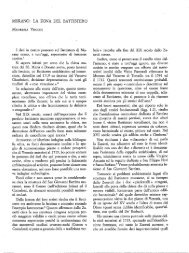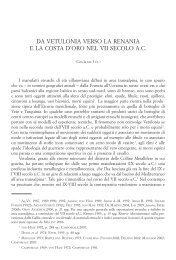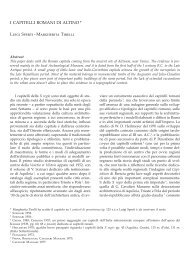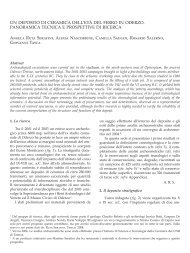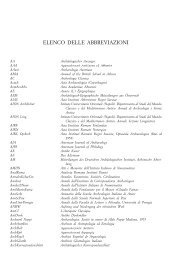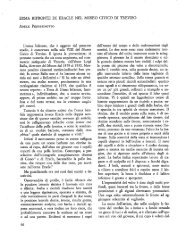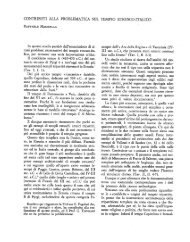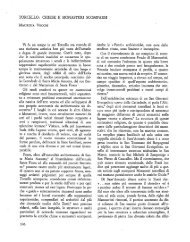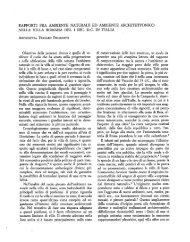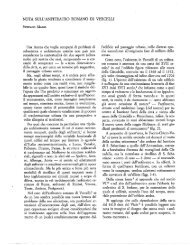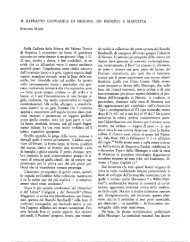RVApI,4/138. - Bretschneider Online
RVApI,4/138. - Bretschneider Online
RVApI,4/138. - Bretschneider Online
Create successful ePaper yourself
Turn your PDF publications into a flip-book with our unique Google optimized e-Paper software.
1981] SOME INTERESTING RED-FIGURE APULIAN VASES 78. BELL-KRATERPadua University, Museo di Scienze Archeologichee d’Arte MB144.(a) Woman with phiale and youth with thyrsus.(b) Two draped youths.The vase is known to me frorn photographswhich are poor; therefore the comments that follow are offered in a tentative way.The drawing recalls the style of the Dijon Painter on whom see <strong>RVApI</strong>, pp. 146; the vase maybe by his own hand. For the dense fold linesdrawn in pairs cf. the maenad on the bell-kraterBerkeley 8/3815, <strong>RVApI</strong>, 6/104 and the womanon the obverse of the bell-krater Matera 9690,<strong>RVApI</strong>, 6/107; for the youth with the thyrsuscf. Dionysos on the Berkeley bell-krater alreadymentioned. The draped youths on the reverse recail those on the Berkeley vase as well as theircounterparts on the bell-kraters Stockholm N.M. 16(<strong>RVApI</strong>, 6/109), Matera 9690 (<strong>RVApI</strong>, 6/107)and Naples Stg. 339 (<strong>RVApI</strong>, 6/139). The meander-pattern with saltire squares is typical of theartist (cf. the bell-krater Stockholm N.M. 16,<strong>RVApI</strong>, 6/109).Second quarter of the 4th century B.C.9. On~ocuo~ (type 3, chous)Rome, Pietro Rotondo Coilection 64.Head of Silen to the left with raised hand infront.Very dose to the Felton Painter, perhaps byhis own hand. On the Felton Painter see <strong>RVApI</strong>,pp. 172 ff. The yase is very similar to the chousno. 63 in the same collection (<strong>RVApI</strong>, 7/96d);it is one of a number of vases decorated with amale head or the head of a silen placed dose toeach other and dose to the Felton Painter.Second quarter of the 4th century B.C.10. HYDRIAGeneva Market (Nicolas Koutoulakis).Figs 13-16Scenè at naiskos: in the centre naiskos with astone «flower bud » in it; the podium of thenaiskos is decorated with a paimette and twolotus flowers. On the left, youth holding mirrorand phiale; on the right, woman holding ari openwreath. On the ground, phiale and wool basket.I don’t know any exact parallel to the « flowerbud» within the naiskos, but it obviously resembles the objects called by Lohmann «Balusterfbrmige Grabmiiier» (Hans Lohmann, Grabmiilerauf Unteritalischen Vasen, pp. 161 fE). ProfessorTrendail also brought to my attention the silveralabastron from tomb XXVI at Piceno (Hellenismus in Mittelitalien p. 165 and fig. 42) whichresembles these objects in shape.By the « Fiower Bud Painter ». Stylisticaliy ourvase stands very dose to the hydria GenevaMF 242, <strong>RVApI</strong>, 7/108 amI to the amphora Naples 2253 (mv. 81734), <strong>RVApI</strong>, 7/109. The threevases must be the work of a single artist whom Iname after the object in the naiskos on the newhydria. The facial features of the woman on ourvase resembie those of the right youths on theobserve and reverse of the Naples amphora (Pi.figs. 17-23) and her drapery recalls that of theseated wòman on the hydria Geneva FM 242 (notethe folds around. the waist). The three vases arealso closely linked by their maeander-patterns; andour vase and the Naples amphora are further connected by the fiorai ornaments under the handles.The connexion of the bell-krater York 21, <strong>RVApI</strong>,7/107 with the three vases attributed to the Flower-Bud Painter is clear, but I am not sure whetheì it should be attributed to the painter himself.In addition to being related to the Felton Painter,our artist is also reminiscent of the Iiiupersis Painter’s style, on whom sec <strong>RVApI</strong>, pp. 185 ff. Forthe importance of naiskos scenes in the work ofthe Iliupersis Painter see <strong>RVApI</strong>, pp. 186 ff.Second quarter of the 4th century B.C.il. On’~oci-io~ (type 3, chous)Addiphseck, Schloss Fasanerie 172.CVA 2, PI. 75, 4; A. D. Trendail, The Red-Figured vases of Lucania, Campania and Sicily, p. 180,no 1085.Satyr pouring wine from an amphora into asitula-like large vessel and maenad holding kantharos and branch.By the Painter of Athens 1680 on whom see<strong>RVApI</strong>, pp. 240 ff. The maenad is especially dosein style of drawing to the maenad on the obverseof the column-krater Ruvo 603, <strong>RVApI</strong>, 9/111.For the dotted quartered square of the maeanderpattern cf. the pelike in the Elis Jenkins Collectionin Neath, <strong>RVApI</strong>, 9/129. The vase was originally
8 ALEXANDER CAMBITOGLOU RdA 5placed by Trendali near the work of the LucanianPainter of New York 52.11.2. He ùow agreeswith me that it should be removed from that list.Second quarter of the 4th century B.C.12. SQUAT LEKYTHOSAscona Market, Galleria Casa Serodine.<strong>RVApI</strong>I, Appendix I, Addendum Chapter 6, no237a. *Warrior holding spear ami shield, Eros holdingthymiaterion and phiale with fruit, woman hol~ding mirror; in the field tambourine and flyingbirci with wreath clutched in its claws.By the Lampas Painter on whom see <strong>RVApI</strong>,pp. 283 ff. This is the only known squat lekythosby the artist. The painter was first identffied anddiscussed in .BSR 19, 1951, pp. 39-42. Noteworthy are the similarities of the Eros and the womanon the Ascona vase with the corresponding figureson the pelike Taranto 8890, <strong>RVApI</strong>, 10/237,Pi ..., figs. 26-27. The bird with the wreath Isvery similar to that on the mug Oxford 1934.17,<strong>RVApI</strong>, 10/2?4.350-345 B.C.13~ COLUMN-KRATERFigs. 24-25Padua University, Museo di Scienze Archeologichee d’Arte MB 139.(ai Woman holding patera and situla running tothe right followed by youth holding bunch of grapes and phiale. (b) Two draped youths at altar.The drawing suggests that the vase should beplaced in the Snub-Nose Group, on which see<strong>RVApI</strong>, pp. 317 ff; it may well be by the SnubNose Painter himself. For the youth’s anatomyad the woman’s drapery cf. especially the obverses of the bell-kraters Bologna 599, <strong>RVApI</strong>, 12/5,Lecce 605, <strong>RVApI</strong>, 12/13 and Trieste S398,<strong>RVApI</strong>, 12/17 as well as the obverse of the còlumn-krater B.M. F300, <strong>RVApI</strong>, 12/24. For theyouths on the reverse cf. the bell-krater in Bolognaand the column-krater in Trieste mentioned aboveand also the belI-krater Lecce 4811, <strong>RVApI</strong>,12/18. For the characteristic - maeander-patternwith the dotted quartered squares cE. all the vasesalreacly mentioned. Strikingly reminisceht of thePadua vase is also the column-krater SeattleCS 202, <strong>RVApI</strong>, 12/30.Late second quarter of the 4th century B.C.14. BELL-KRATER Figs. 30-31Pavia, University, Arch. Institute, old inv. 156.(a) Woman holding phiale running to the leftfollowed by youth holding situla and phiale. (b)Two draped youths.The vase belongs to the Snub-Nose Group onwhich see <strong>RVApI</strong>, pp. 317 ff; it may be the workof the painter himself. Cf. the drapery of thewoman and the anatomicai details of the youth onthe observe with the cotresponding features onthe observe of the bell-krater Bologna 599, <strong>RVApI</strong>,12/5. With the youths and the plant on thereverse cf. the youths and the plant on the reversèof the bell-krater Lecce 605, <strong>RVApI</strong>, 12/13. ThePavia vase stands dose also to the bell-kratersTrieste 5 398,~<strong>RVApI</strong>, 12/17 and Lecce 4811,<strong>RVApI</strong>, 12/18 and the column-krater in Paduahere no. 14.Late second quarter of the 4th century B.C.15. AMPI-IORA Figs. 32-33Pavia, University, Arch. Institute old mv. 157.(a) Youth and seated woman holding wreathFigs. 8-29 and cista at stele decorated with ffllet. (b) Twodraped youths.By the Varrese Painter on whom see <strong>RVApI</strong>,pp. 335 ff. The youth on the odverse with hishimatjon hanging over one arm and envelopingthe hand, and with legs crossed is a stock figurein the artist’s work; cf. corresponding figures onthe amphora B. M. F333, <strong>RVApI</strong>, 13/6 and thevolute-krater B.M. 1933~ 6-13.7, <strong>RVApI</strong>, 13/9.Typical also is the seated woman by her pose, thetreatment of the drapery and her head-gear; cf. theseated women on the obverses of the amphoraBonn 99, <strong>RVApI</strong>, 13/3 and the volute-kraterB.M. P282, <strong>RVApI</strong>, 13/27.: The youths on thereverse recail those on the reverses of the beilkrater Basel Market, M.u.M4 <strong>RVApI</strong>, 13/13 andthe amphorae Bologna 525, <strong>RVApI</strong>, 13/39, Bologna 526, <strong>RVApI</strong>, 13/40 amI Leningrad 509St. 1210, <strong>RVApI</strong>, 13/42 as well as those on thereverse of the pelike Bologna 540, <strong>RVApI</strong>, 13/89.Typical of the artistic style are also the rosettesand the halteres in the field, the fiilet tied aroundthe shaft of the stele, the dotted wreath held bythe woman on the obverse and the maeanderpattern with the dottèd quartered squares; for
lo ALEXANDER CAMBITOGLOU [RdA 5seated holding a syring and a branch and lookingtoward Aphrodite who is seated on the right holding a fan; in the middie an Eros is moving towardAphrodite holding four fillets, a phiale and a junx.(b)-Seated maenad holding thyrsus and open cistabetween young satyr holding torch and situla andyouth (or youthful Dionysos) holding thyrsus andmirror.The subject on the obverse is fairly popular inLate Apulian but I don’t know any representationsof. it in the early phase of the style and it appearsonly four times in Middle Apulian.The earliest extant representation is on the beilkrater by the Iliupersis Painter, Louvre K 3,<strong>RVApI</strong>, 8/17 in which Europa is seated in thecentre by a pool, while the buil Is approachingfrom the right. Fiere Europa appears to have justnoticed the animai and this must be the eariieststage in the development of the story.The amphorae by the Darius Painter Bari 872,<strong>RVApI</strong>I, 18/44 and Napies 3218, <strong>RVApI</strong>I,18/46, the caiyx-krater in the manner of the Darius Painter Vatican AA1 (inc. 17200), RVApii,18/113, the amphora by the Perrone Painter Vatican X7, <strong>RVApI</strong>I, 18/227 and the pelike MilanA1868 (old no St. 6874) attributed to the Painter of Zurich 2657, RVApii, 18/367, representthe second stage, in which Europa moves towardthe buil trying to touch hint These are highlyanimated compositions and some of them includea number of figures. Interesting variants of thesecond stage are represented on the Ascona situlaand on the chous associated with the CapodimontePainter Taranto 54079, RVApii, 28/35*. On theformer Europa is represented kneeling in front ofthe buil about to caress him, on the latter sheappears reaching toward him while sitting on arock-pile; on both vases the atmosphere is idyllic.The third stage of the legencl where Europa hasalready mounted and is riding the buil appears onthe fragment of the Group of Oxford G 269 Kiei,Private Collection, RVAp1, 15/24, on the fragment of the Berlin Ganymede Group Copenhagen13433, <strong>RVApI</strong>, 16/50 and on the amphora BerlinF3241, <strong>RVApI</strong>1, 18/234 which is terribly overpainted but which must belong to the circie of theDarius Painter. With these three vases goes thestemless cup by the Patera Painter Vienna 189* For a photograph of this vase I am indebted toProfessor A. D. Trendall.(S.K. 164.93) <strong>RVApI</strong>I, 23/43 which represents,in the tondo, Europa and the buil in a very mannered composition in which Europa is almostmounted and looking as if she is floating in the airwhile the buil has already started running.**The style of drawing of the Ascona situla recallsthat of the Chamay Painter on whom see <strong>RVApI</strong>,chapter 16, section 3. The idyllic atmosphere ofthe scene on the obverse of the situla is charaeteristic of the artist’s scenes and our vase is alsoconnected with his works by such features as therows of white dots indicating the various levelsof the ground and the dense double lines indicating the folds of drapery. The figure of the kneeling Europa stands very dose to the kneeling woman with the child on the hydria Berlin P3291,<strong>RVApI</strong>, 16/60. Our vase, nevertheless, differsfrom those attributed to the Chamay Painter bythe treatment of the profile heads and more especially the facial features which are here sharper(the lines of the eyebrows, for example, are notas curved as they are on vases by the painterhimseif); the reverse of our situla takes us furtheraway from the painter. I prefer therefore to piacethe Ascona vase dose to the Chamay Painterrather than attribute it to him unreservedly.About 350 B.C.20. P~xxs (round) Figs. 40Sydney, Private Coilection, on loan to the Nicholson Museum.On the lid: bearded head in profile iookingleft; in the field unidentified object.The style reminds one of the early work of theDarius Painter on whom see <strong>RVApI</strong>1, chapter 18,section 2. Cf., for example, the curly hair and laurei wreaths of the Sydney pyxis which are treatedin high relief lines with those of Apollo on theobverse of the volute-krater B.M. F 279, <strong>RVApI</strong>I,18/17. With this figure the head of our. pyxisshares another feature, the outlining of the noseand forehead by means of relief lines against theSince writing this article another vase with a representation of the third stage of the legend came tothe notice of Professor Trendali and myself, the dinos)n stand Bloomington, Indiana University An Museum80.27.2 (<strong>RVApI</strong>I, Additions to Vase-lists 18/233a,where it is placed dose to the Perrone Painter, butconsidered also to be a possible work by the DariusPainter himself) on which Europa appears on the buliescorted by women riding sea creatures.
1931 SOME INTERESTING RED-FJGURE APULTAN VASES :I~1biack-painted background. Like so many faces inthe figure-work of the Darius Painter the face onthe pyzis has a good deal of character (cf. the faceof Agamemnon on the loutrophoros B.M. 1900.5-19.1, <strong>RVApI</strong>, 18/19); this is due partly to thepronounced lines of the eye, the crows-feet ofwhich are also indicated (cf. the crows-feet of theeyes of the paidagogos on the volute-krater B.M.F 279, <strong>RVApI</strong>I, 18/17; these are also indicatedon the face of Kreon on th eamphora Ruvo 423 ofthe Group of Ruvo 423 (<strong>RVApI</strong>, 13/41) withwhich the head on the Sydney pyxis Is also stylistically connected).Eearly third quarter of the 4th century B.C.21. PELIKE Figs. 41-42Basel Market (Palladion).(a) Bridal scene. Above: Aphrodite in bigadrawn by two Erotes; beiow: woman seated oncouch and youth offering her an unidentifiedobject; on the ieft: seated woman holding parasol;on the right: woman with fan near incense-burner.(b) Woman seated on large cista between youthholding bunch of grapes and woman holding fan.By th~ Darius Painter. The pelike beiorigs moreparticularly to the Hecuba Sub-group on which seeRVApii, 18/17 ~. li is one of a number of largepeiikai on which the Darius Painter representedbridai scenes (cf. Turin 4149, <strong>RVApI</strong>I, 18/25).Characteristic is the treatment of the profile headof the youth on the obverse for which there is adose paraflel in the head of Apollo on the volutekrater B.M. F279, <strong>RVApI</strong>, 18/17. The pose anddrapery of the bride can be compared with thoseof the bride on the pelike Vatican Y 23 (mv.18129), <strong>RVApI</strong>I, 18/27. Far the mattresses andthe cushions of the bride’s couch and the branchesunderneath indicating that the scene takes piaceoutdoors cf. the pelike Napies Stg. 702, <strong>RVApI</strong>I,18/24. The bird has a counterpart on the obverseof the pelike Vatican Y 23, <strong>RVApI</strong>T, 18/27, andthe tali youth on the reverse, with his coat hanging behind his back and over his raised forearms,resembies the youth on the reverse of the pelikeNapies Stg. 702, <strong>RVApI</strong>I, 18/24. For the composition of the figures on the reverse cf. the threeiower figures on the reverse of the Pelike in aGerman Private Coilection RVApiI, 18/69.The iotus-palmette pattern on the neck of theobverse is also typical of the Darius Painter (cf. thelotus-palmette bands on Vatican Y 23 <strong>RVApI</strong>I,18/27); so is the maeander-pattern with the dotted quartered squares (cf. the maeander-patternson the volute krater B.M. F279, <strong>RVApI</strong>I, 18/17and also that on the squar Iekythos B.M. F 399,<strong>RVApI</strong>1, 18/35.Third quarter of the 4th century B.C.22. AMP~-IORA Figs. 43-44Pavia, University, Arch. Institute, old mv. 158.Arturo Stenico in Acme X, 1957, fasc. 1-111,p. 203 ff, PI. 11, figs. 7-9; <strong>RVApI</strong>I, 23/166 amI24, (i), a.(a) Eros holding fan and fillets walking towardaitar to left. (b) Head of woman.The obverse is by the Patera Painter on whomsee <strong>RVApI</strong>I, chapt~r 23. The artist’s styie wasfirst identified in fF15 1954, p. 229, where fourof his vases were put together: the column kratèrsBologna 579, <strong>RVApI</strong>I, 23/131; Karlsruhe B 136,<strong>RVApI</strong>I, 23/132 and Bologna 577, <strong>RVApI</strong>I,23/133 and the bell-krater Karlsruhe B 218,<strong>RVApI</strong>I, 23/153. The reverse is by the Amphorue Painter, on whom see <strong>RVApI</strong>I, chapter 24. Cnthe relation between the Pater and AmphoraePainters see <strong>RVApI</strong>I, Iast paragraph of mntroduction to chapter 23.The Pavia amphora is one of a number ofvases with figured scenes by the Patera Painteron the obverse and female heads of the AmphoraeGroup on the reverse (RVApii, chapter 23, iv).For the Eros on the obverse cf. the columnkrater once Milan Market Casa Geri, Sale Cat.no. 7, 1966-1967 (March 1967), no. 1123 (iii.),ex Arno Collection, Sale cat. no. 76 (III.), <strong>RVApI</strong>I,23/176. For the lead on the reverse cf. the amphora Lecce 842, CVA 2, IV Dr, Pi. 44, 2-3 and5(<strong>RVApI</strong>I, 23/162) and the column-krater Bologna 582, CVA 3, IV Dr, p1. 16, 3-4 (<strong>RVApI</strong>I,23/ 171).c. 330-320 B.C.23. AMPHORAPadua, University, Museo di Scienze Archeologiche et d’Arte M.B. <strong>138.</strong>(a) Head of woman. (b) Head of woman.
14 ALEXANDER CAMBITOGLOU ERdA 5The vase belongs to the Copenhagen Group andforms a pair with the vase listed in this articleas no. 27.C. 310 B.C.29. P~xis (round)Ascona Market, Galleria Casa Serodine.Katalog 1979, no. 32, ill. on p. 35; <strong>RVApI</strong>I,29/630.Cn ud: head of Nike.The vase belongs to the Kantharos Group, onwhich see <strong>RVApI</strong>I, chapter 29, section 6, and isespecially dose to the mugs Leiden G.N.V. 109,<strong>RVApI</strong>I, 29/611 and Hamburg 1917.1073 a-b,<strong>RVApI</strong>I, 29/609. Note the kekryphalos, the serrated forehead and the treatment of the eye inprofile by means of four iines, one of them between the eyebrow and the upper eyelid indicatingthe recess, where the skin is reflected over thebone of the superior orbital ridge. The rathersmudgy dilute-paint band over the necklace is acharacteristic feature on a number of vases ofthis group.About 310 B.C.30. LEKANIS LuiPadua, University K72.Two heads of women.The vase belongs to the Kantharos Group onwhich see <strong>RVApI</strong>I, chapter 29, section 6. Characteristic of our vase is the treatment of the eyesby means of four iines meeting at one end and thedot at the mouth. Particularly dose to the Paduaud are the Kantharos Milan 220, RVApii,29/428, the plates Budapest 50232, <strong>RVApI</strong>I,29/480 and Canosa 220 and 486, <strong>RVApI</strong>I,29/482 and 485 and the oinochoe Berlin F3319,<strong>RVApI</strong>i, 29/551.About 310 B.C.31. SICYPHOS (type A, large)Zurich Market, Galerie Arete.Fig. 55(a) Head of woman. (b) Head of woman.For the shape cf. G.M.A. Richter and M. J.Milne, Sbapes and Names o/ Athenian Vases,fig. 177The vase was originally piaced in the Kantharos Group (Generai), then moved dose to <strong>RVApI</strong>I, 29/17.The vase stands styiistically very dose to theskyphos of Corinthian type number 32 in thisarticle and I have no doubt that the two vasesare by the same artist, whom I would iike to cali« The Painter of the Large Skyphos» because ofthe unusually large size of our vase.The style of this artist is characterised especiallyby the treatment of the eye, in which the lowereyelid is an upward curving line forming an angiewith the line indicating the eyeball, which curvesslightly to the right (in the Kantharos Gropp thesetwo parts of the eye are normaily indicated by asingie downward curving line). The two vases arealso connected with each other by the kekryphalosand the triangular earrings.Because of the treatment of the eyes the Painterof the Large Skyphos has some affinity with thePainter of Brunswick 307.8 (<strong>RVApI</strong>I, chapter 29,section 6, division (ii)), and stands especialiy doseto the Painter of Marburg 788 (<strong>RVApI</strong>I, chapter29, section 7, divisioii (iii)); cf. also the heads onthe mug Hamburg 1876.287 and the lekanis lidNaples H 620 listed in <strong>RVApI</strong>I, chapter 29, section 3 as nos. 281-282.Last quarter of the 4th century B.C.32. SKYPHOS (Corinthian type) Fig. 57Zurich Market, Galerie Arete.(a) Head of woman. (b) Head of woman.By the Painter of the Large Skyphos. See thecomments on the skyphos listed in this article asnumber 31.Last quarter of the 4th century B.C.33. OINOCHOE (shape 1) Fig. 58Once Athens, Acheloos Gallery 340.Head of Woman.F~ ig. ~ 6 theThis Acheloos and theGallery following Athens three vases are by alsotheonce same inartist, who should be the Painter of Marburg 788(<strong>RVApI</strong>I, chapter 29, section 7, division (iii))associated in <strong>RVApI</strong>I with the Kantharos Group.The styie of this painter is characterised by thetreatment of the profile eye, in which the eyebrow,the line between it and the upper eyelid as well as
1981] SOME INTERESTING RED-FTGURE APTJLIAN VASES 1Ythe upper and Iower eyelids curve upwards, oftenwithout meeting near the nose, while the lineindicating the eyeball curves to the right.To this painter I would also assign the oinochoePhlladelphia 50.1.99 (fig. 59) iisted in <strong>RVApI</strong>Iin chapter 29 as numbero 592 (Kantharo6 Group,Generai).Last quarter of the 4th century B.C.34. On’ioci-~o~ (shape 1)Once Athens, Acheloos Galiey 338.Head of woman.By the same hand as the oinochoe no. 33 in thisarticle.Last quarter of the 4th century B.C.35. KANTHAROSOnce Athens, Acheloos Gallery.(a) Head of woman.By the artist of the oinochoai listed as numbers33 and 34 in this article.Last quarter of the 4th century B.C.36. KANTHAROSOnce Athens, Acheloos Gallery.(a) Head of woman.By the artist of the oinochoai listed as numbers33, 34 and 33 in this article.Last quarter of the 4th century B.C.The vases discussed in this article cover a periodof approximately one hundred years; some belongto the plain style but most of them are ornate(<strong>RVApI</strong>, p. XLIX). Although these vases vary inimportance they ali have some interest for the student of Italiote wares and a few among them areoutstanding.The belI-krater no. 1 on the list is undoubtedlythe best among the known vases by the Painterof Bologna 498 and the pieces nos. 2 and 3Fig. 60 constitute important additions to the output ofthe Painter of the Long Overfalls, who is a majorfoliower of the Tarporley Painter. In addition toits interest from the iconographic point of view,the hydria no. 10 is noteworthy as the name vaseof a new individuai artist, whose work is nowclearly defined, while the pelike no. 18 is a significant addition to the oeuvre of the Chamay Painter, one of the most delicate Apulian artists.Iconographically spealdng, the two most important vases of my list are the situla no. 19 and thehydria no. 24. Although originally Professor Trendall and I attributed the situla to the Chanuy Pain.ter himself, I now think that it should rather beplaced dose to him. The hydria, on the other hand,Is characteristjc of the monumentai work of theBaitimore Painter and forecasts the style of theWhite Sakkos Painter.A word should also be said about the merits ofthe littie pyxis no. 20, which I attribute to theDarius Painter. It bears the stamp of mi artistwho never stops surprising us by the incrediblyrich repertory of his mythological subjects and bisstyle of drawing which is fuli of character.University o! SydneyAustralia
(-37-iPV‘7ri(-‘itv~tF Ir•~1~~~..~~oo
6 ~IJ8 8H9 ~!d•L •8~dnO]OO.LIHNVD
TI ~iJ -~E ~.‘d•11 ~?d 01 ~!JflO7DOJ.I~NV3
CAMBITOGLOUFig. 24. Fig. 25.Fig. 40
(5o(-3CN‘5CNCNe-oo
CAMBITOGLOU()Fig. 30Fig. 31I4IFig. 32. Fig. 33.
CAMEJTOGLOUF1g 34Fig. 36.Fig. 37
.sDr ~H[IO]DOI1~VVVD
(-3i(-‘ioo
CAMBITOGLOUjr-.Fig. 48iFig. 49.Fig. 46.Fig. 47 Fig. 50.
Fig. 43. Pig. 44.CAMBLTOGLOU
CAMBTTOGLOUFig. 51Fig. 52.
uLIr\z oo oH-1:
-q-v 09 ~HinQ1Doì1qy~v3



